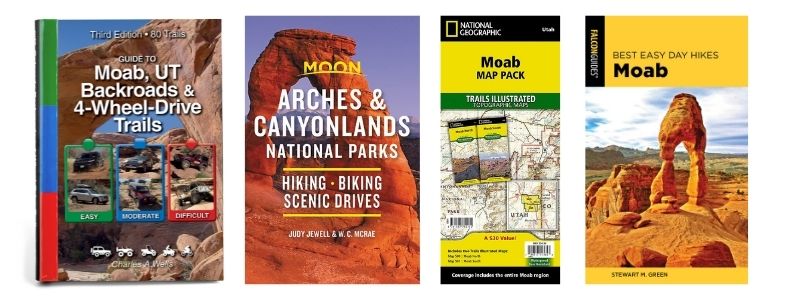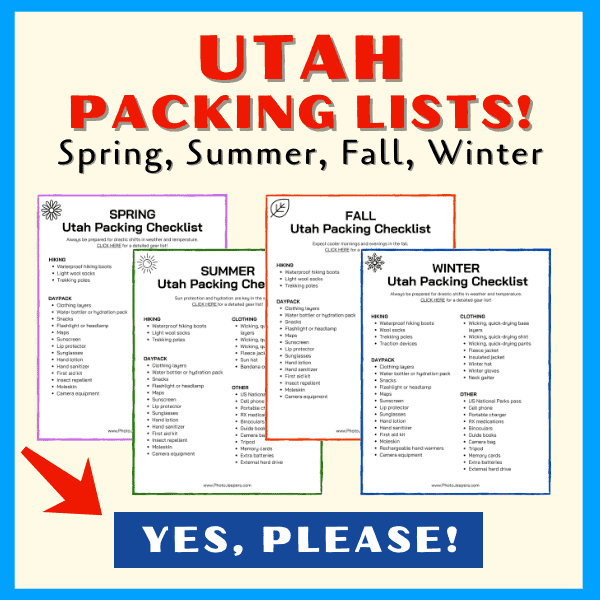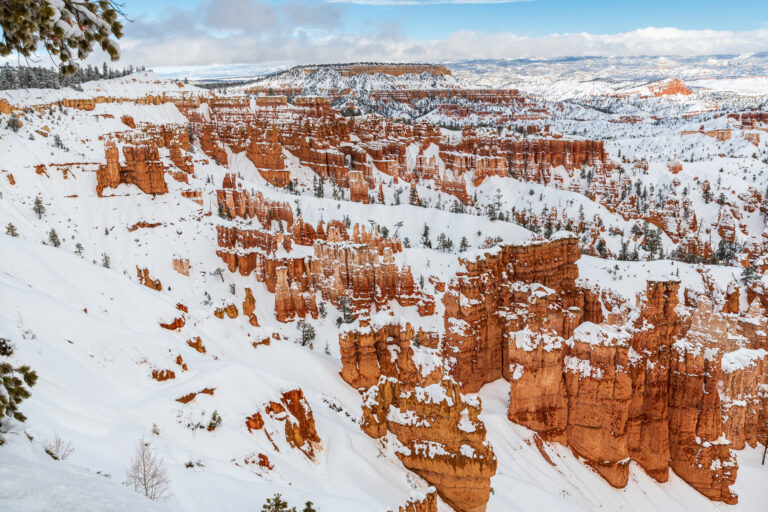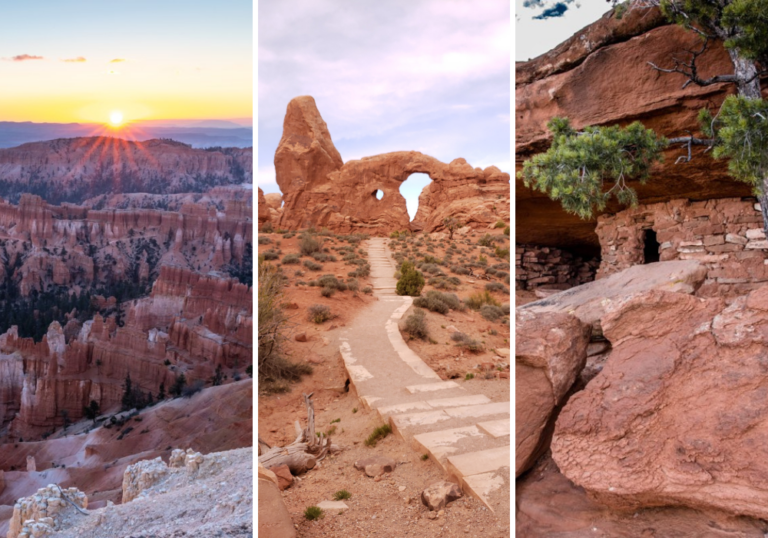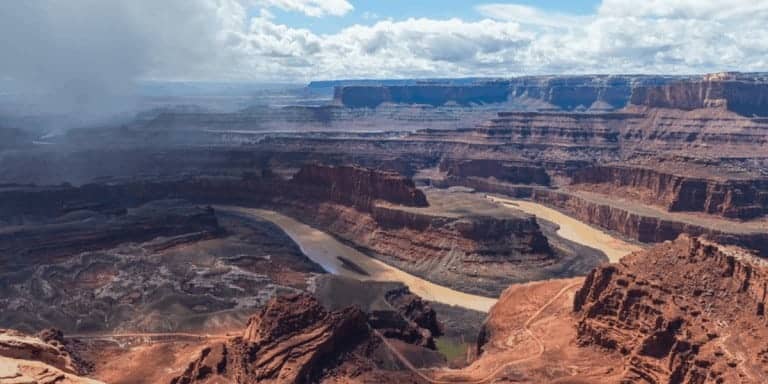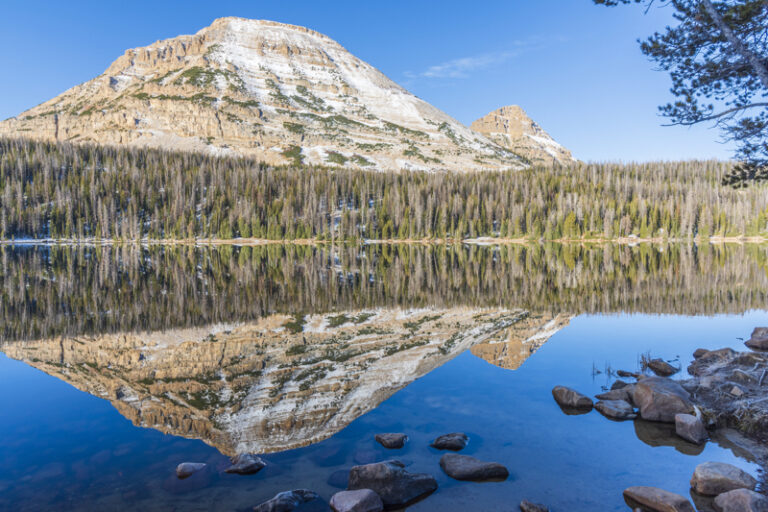Tips to Take Dead Horse Point State Park Photos
Dead Horse Point State Park in Utah offers an iconic view of the Colorado River winding its way through the canyon below. We live just hours away so we’ve had the experience of photographing this view during every season and all types of weather and light conditions.
Check out our tips for taking Dead Horse Point State Park photos of the Colorado River, dramatic vertical cliffs, canyons, and vista views.
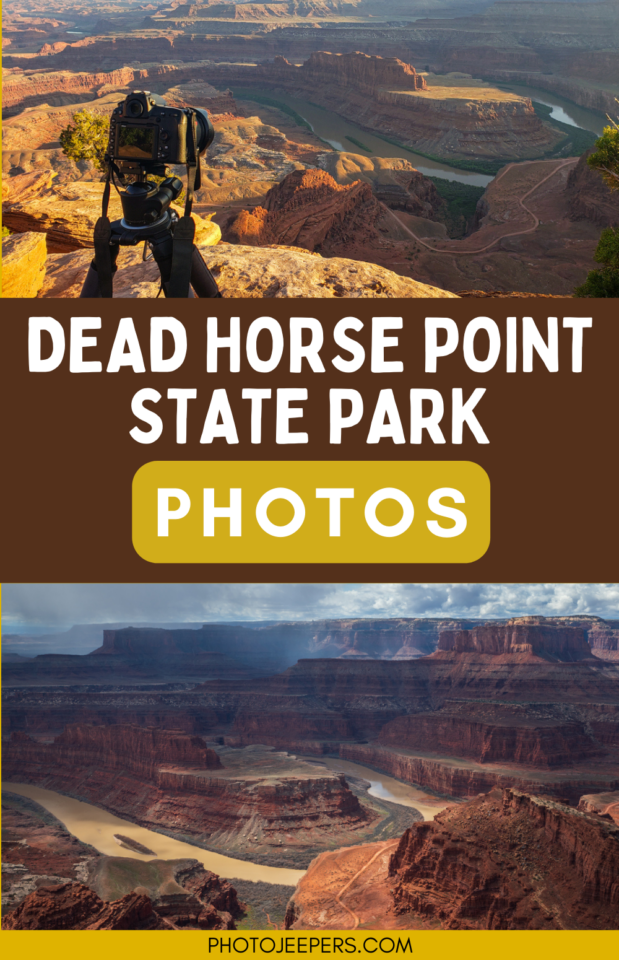
Here’s our list of the best Dead Horse Point photo spots, best times of day to photograph the views, and the camera gear you’ll need to take pictures at this stunning park!
This guide is based on our experiences over the years capturing Dead Horse Point photos with tips for taking sunrise and sunset.
We’ve included a list of camera gear you’ll want for Dead Horse Point. But also remember that it’s important for YOU as the photographer to have the right clothing to brave the cold or heat depending on the time of year you’ll be visiting the park.
Use our Utah Packing Lists to make sure you have the right clothing and gear for visiting any time of year! Grab your free printable packing checklist by clicking the image below!
This site contains affiliate links which means WE may receive commissions for purchases made through these links. We only provide links to products we actually use and/or wholeheartedly recommend! As an Amazon Associate, we earn from qualifying purchases. Read the full Disclosure Policy.
Camera Gear for Dead Horse Point Photography
We have a printed Camera Gear Checklist to help us pack all the equipment we need – that way we don’t forget anything!
- Cameras for Landscape Photography
- Lightweight Travel Tripods
- Camera Backpack: Protecting your camera from the sand and dust at Dead Horse Point is essential. Using a camera backpack is so nice for hiking too.
- Graduated neutral density filter: There can be extreme differences in light around the various rock structures. To compensate for this variance of light you’ll need to use a GND filter.
- Camera cleaning kit: You’ll want to remove dust that WILL get on your lens – this is NOT for cleaning the sensor.
- Memory cards
- External hard drive: Don’t forget to copy the photos to a portable external hard drive ‘just in case’.
- Headlamp with a red light: For the best sunrise, sunset or night sky shots, you’ll be navigating in the dark. Use a headlamp to light your way to/from the parking lot to your spot. Wearing a headlamp allows you to adjust equipment without having to hold a flashlight. Remember to use the red light setting and keep the beam pointed on the ground in front of you to avoid disrupting other photographers in the area taking long exposure shots.
Camera Gear at B&H Photo
Visiting Dead Horse Point State Park
Located near the adventure town of Moab, Dead Horse Point is known for its ever-changing landscape and exquisite views of the Colorado River.
If you’re planning to visit Canyonlands National Park Island in the Sky, this is a must-see side trip!
Dead Horse Point State Park is open year round, between 6:00 am and 10:00 pm.
The US National Parks pass is not valid here since this is a Utah State Park. But we feel the additional fee to visit this park is well worth it to view this iconic scene you can’t see at Canyonlands.
Dead Horse Point State Park Weather
Because the Southeastern portion of Utah is part of the Colorado Plateau, this region is regarded to be a “high desert”climate. As such, Dead Horse Point State Park regularly experiences huge temperature fluctuations, of up to 40 degrees, in a single day.
That’s why the most temperate, and best time to visit the park, is during the spring (between April and May) and the fall (between mid-September and October). Throughout these seasons, daytime highs usually average between 60º and 80ºF (15º and 26ºC) while nighttime lows usually average between 30º and 50ºF (-1º to 10ºC) .
In contrast, summer temperatures regularly exceed 100ºF (37ºC), making strenuous activities difficult. Late summer monsoons also bring violent storms to the areas can cause dangerous flash floods.
Winter weather in the park is similarly extreme, with highs between 30º and 50ºF (-1º to 10ºC) and lows between 0º and 20ºF (-17º to -6ºC). Although heavy snowfall is rare, even trace amounts of snow and ice can make local trails and roads virtually impassable. Be prepared with the right winter clothing so you’ll want to be out taking pictures! We recommend photographer gloves and rechargeable hand warmers!
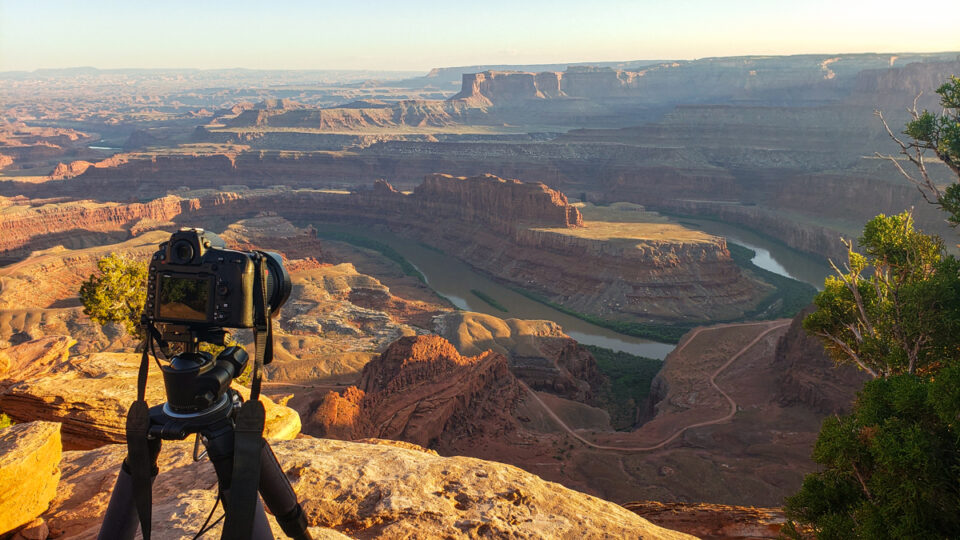
Tips to Take Dead Horse Point State Park Photos
When it comes to capturing the stunning landscape of Dead Horse Point, it’s crucial to consider a few basic photography techniques. We’ll give a brief summary here then provide more details and Dead Horse Point photos to illustrate the concepts.
First off, aim to shoot during the golden hours — just after sunrise or just before sunset. The soft, warm lighting during these hours brings out the vivid colors and intricate textures of the landscape, creating stunning contrasts.
Don’t forget to about using perspective in photography to create a sense of depth and scale. Capturing the expansive canyon from various angles can result in truly unique shots.
Lastly, use a wide-angle lens to encapsulate the grandeur of the scene and a tripod to ensure stability for those long-exposure shots.
Remember, patience is key: wait for that perfect moment when the natural light and landscape align, and you’ll be rewarded with a breathtaking photograph of Dead Horse Point.
Dead Horse Point Drone Photography Guidelines: Drones are banned between March and October when it’s the busy season. The use of drones at the main viewpoint of Dead Horse Point is always prohibited.
Between November 1st and February 28th/29th of every year, drones may be used in the park, but only with proper permits. Permits can be obtained at the visitor center or bring your completed drone online permit for Utah State Parks with you where they must then be approved by park staff.
Dead Horse Point Sunset Photography
The best time to photograph Dead Horse Point is at sunset when the landscape gets that red glow.
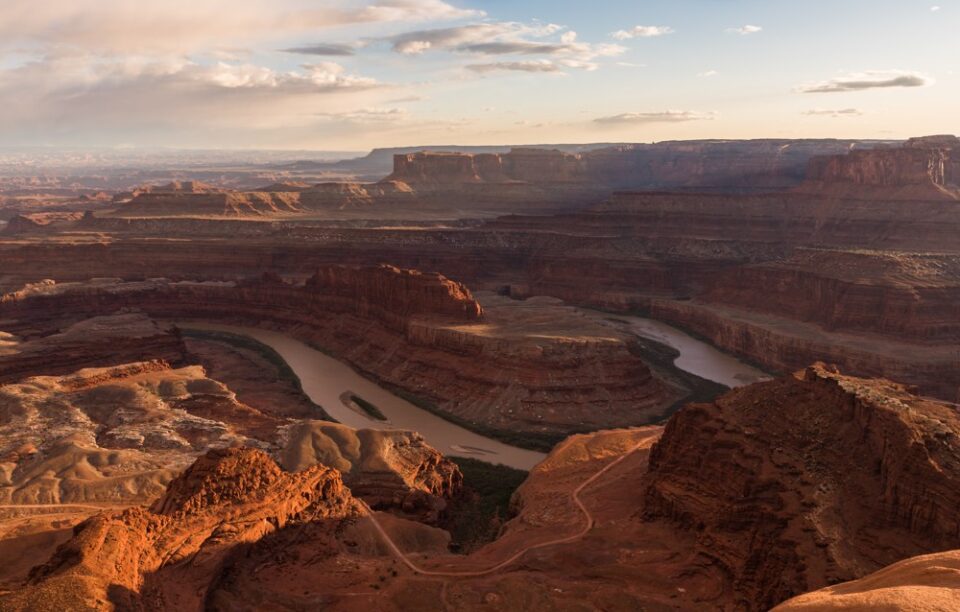
It’s a popular spot for people to watch and photograph the sunset, but there is plenty of room along the canyon rim for everyone to have a great view!
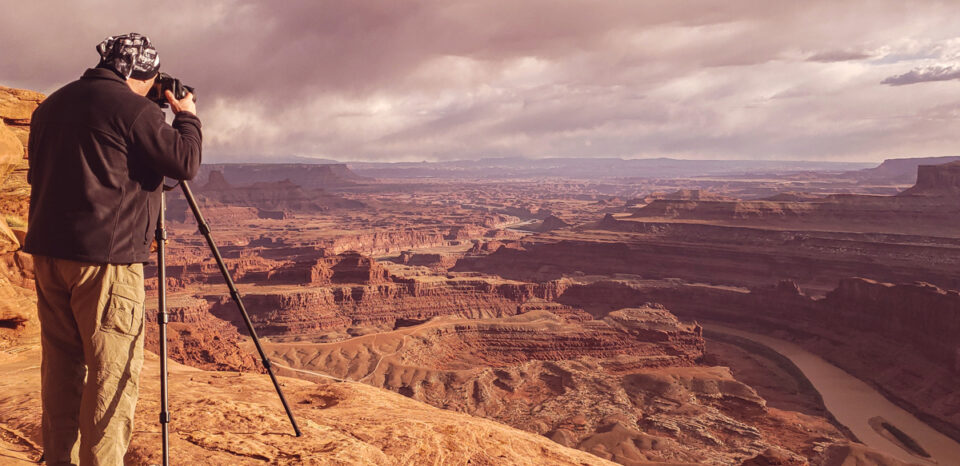
We have found it best to find a spot along the trail below and to the right of the platform to capture the Dead Horse Point sunset.
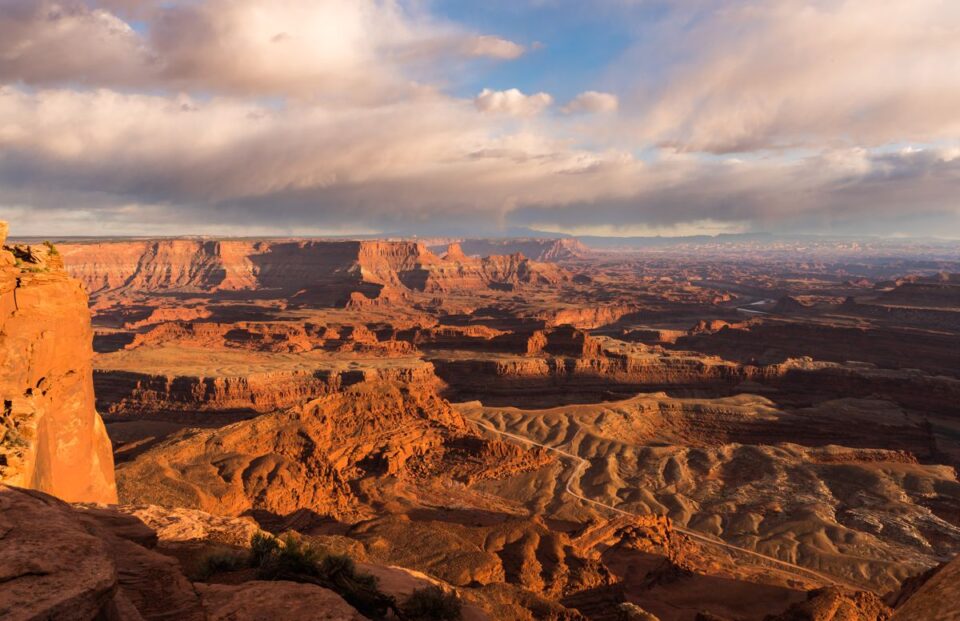
Don’t forget to look all around you to capture photo opportunities like the red glow on the rocks. This isn’t the iconic scene of the Colorado River, but it’s a stunning landscape photo of the area!
Use Scale For Taking Dead Horse Point Pictures
Using scale in photography is an effective method of communicating to viewers the size of the subject being captured.
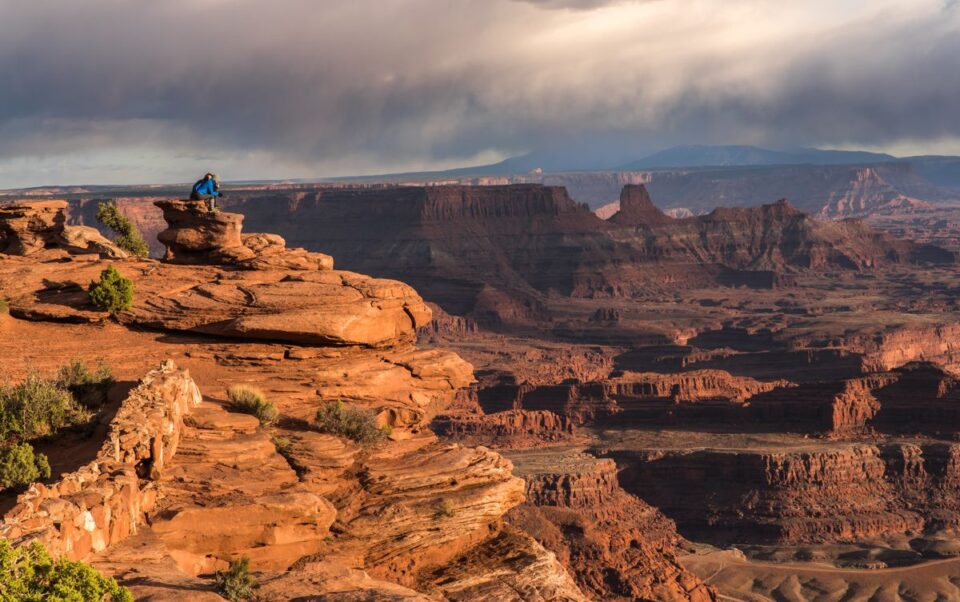
This is accomplished by including an element in the photograph, like people, that is a commonly recognized subject. Taking a picture of this couple watching the sunset at Dead Horse Point helps is a way to show the scale of people compared to the surrounding area.

The photo above of Dave photographing Dead Horse Point helps the viewer conceptualize the vast expanse of the landscape compared to the size of the man.
Dead Horse Point Blue Hour Photography
Another tip we have is to stay after the sun sets to capture some blue hour photos at Dead Horse Point. Blue hour happens roughly an hour after sunset when the indirect sunlight is dominated by blue wavelengths.
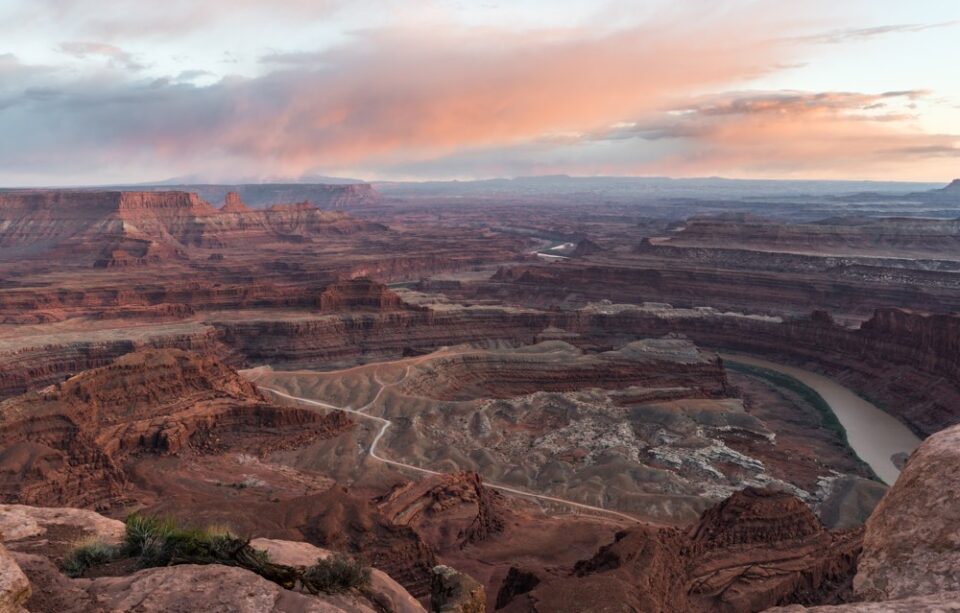
While you’re waiting for that blue hour light, keep taking photos to capture that transition from golden hour to blue hour. Sometimes after the sun goes below the horizon, the clouds will illuminate with color!
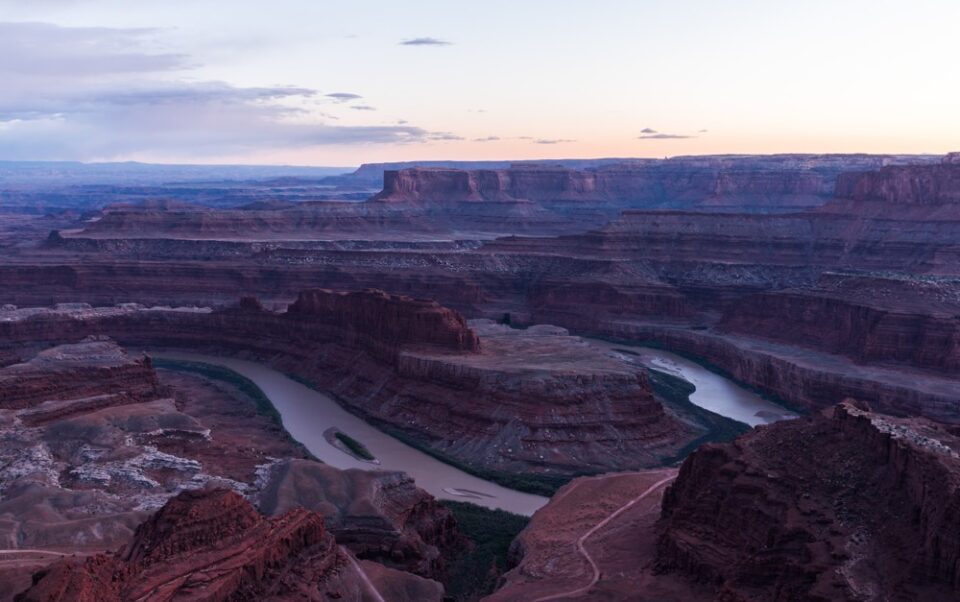
Blue hour provides soft, diffused light, and while it may appear too dark to the naked eye, you’d be surprised at how much light your camera will pick up during the blue hour.
Wide Angle and Panorama Photos at Dead Horse Point
Locations that are grand in scope like Dead Horse Point, often require the use of a wide angle lens, or a panoramic technique to adequately capture the scene.
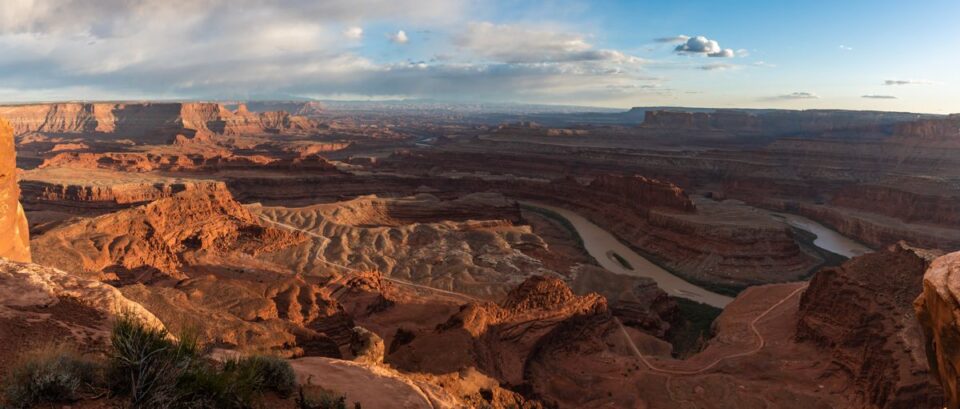
The panoramic image above illustrates the grand scale of the view you’ll see at Dead Horse Point. It was created by taking a series of overlapping photos of the scene and merging them together digitally in Lightroom.
We also took a photo using the wide-angle lens we had, but it wasn’t wide enough to capture the full landscape in a single photo.
Fill the Frame When Taking Dead Horse Point Photos
One of the easiest ways to amp up the wow factor in your travel photos is to fill the frame with your main subject.
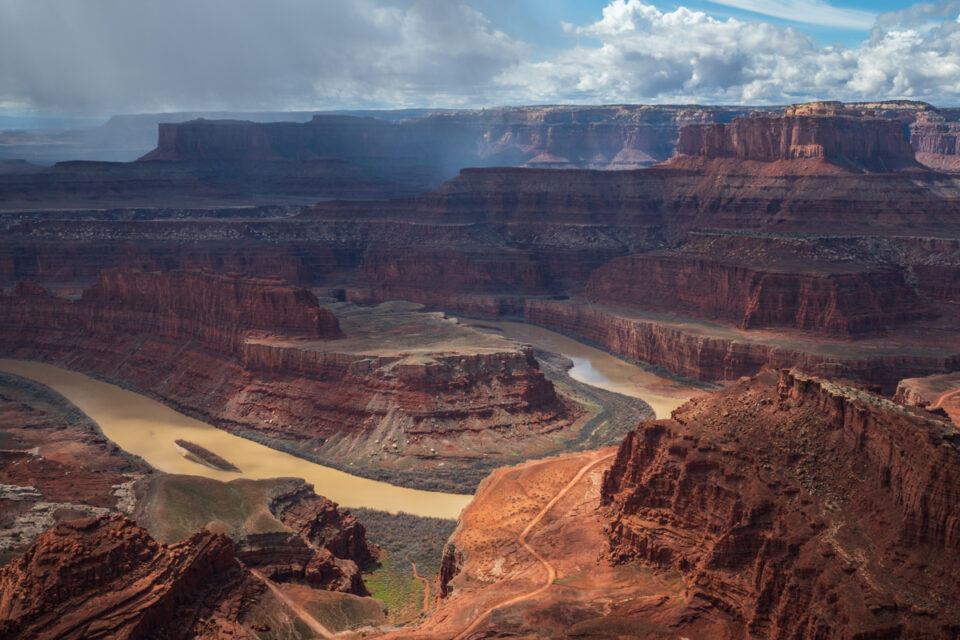
In other words, draw the viewer’s eye to the subject of your photo by getting closer or zooming in on the part that matters.
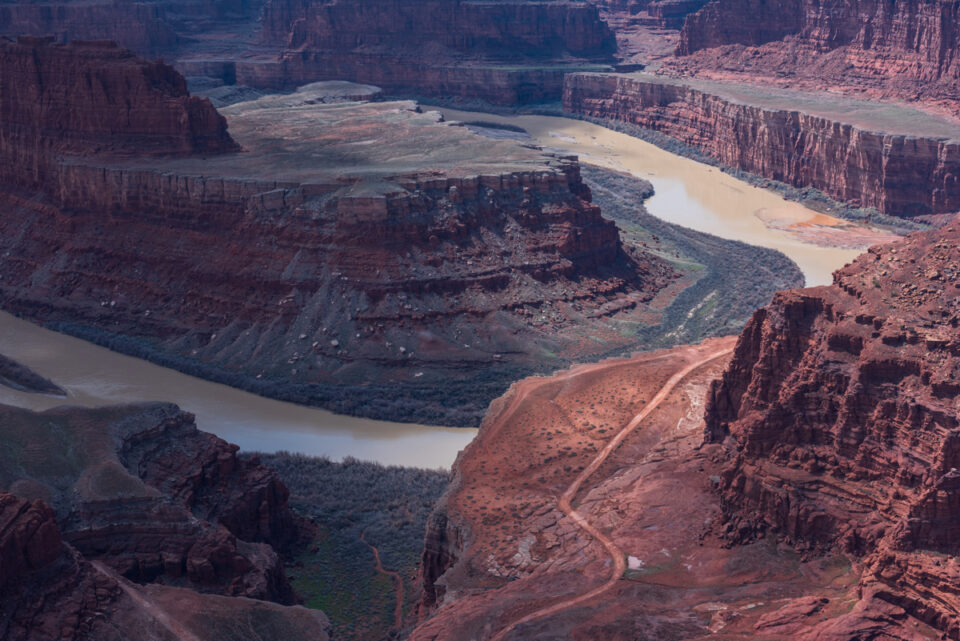
Since we can’t physically move closer to the Colorado River at Dead Horse Point, we can use a zoom lens to fill the frame to create impact!
Weather Elements Taking Dead Horse Point Photos
In landscape photography, composition, light, subject and story make a good photograph. Use weather elements in photography to your advantage!
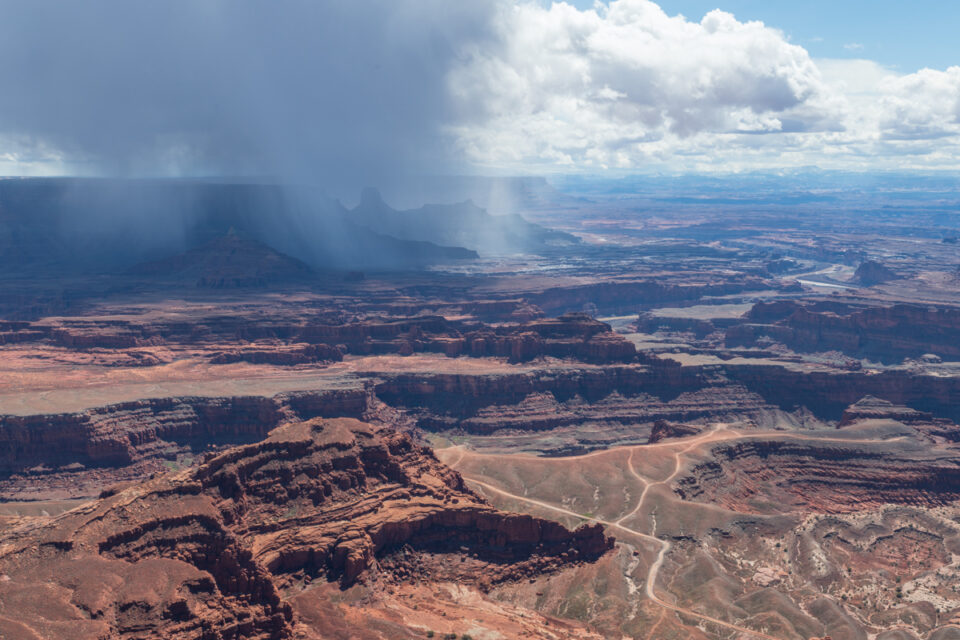
When a rain storm rolled through our view from Dead Horse Point, we were able to capture the isolated downpour! Seeing this rainstorm was not just a cool weather event, but a powerful reminder of nature’s strength and beauty in transforming the landscape in the area.
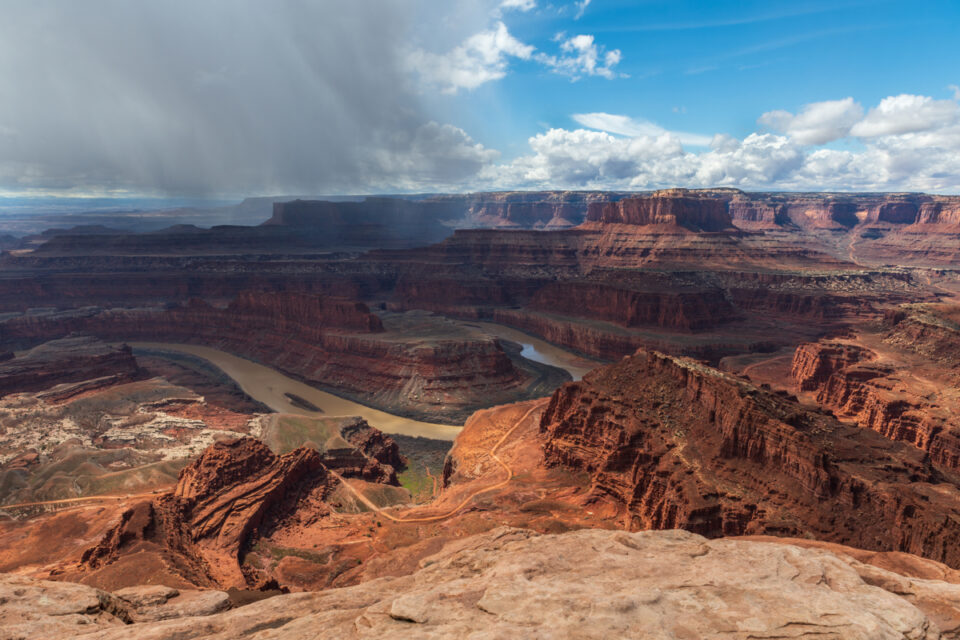
The rain clouds also created cool contrasts of light and shadow in the scene. The visual impact of the clouds and the rain created ever-changing patterns that add to the mood, motion and depth in this photographic story.
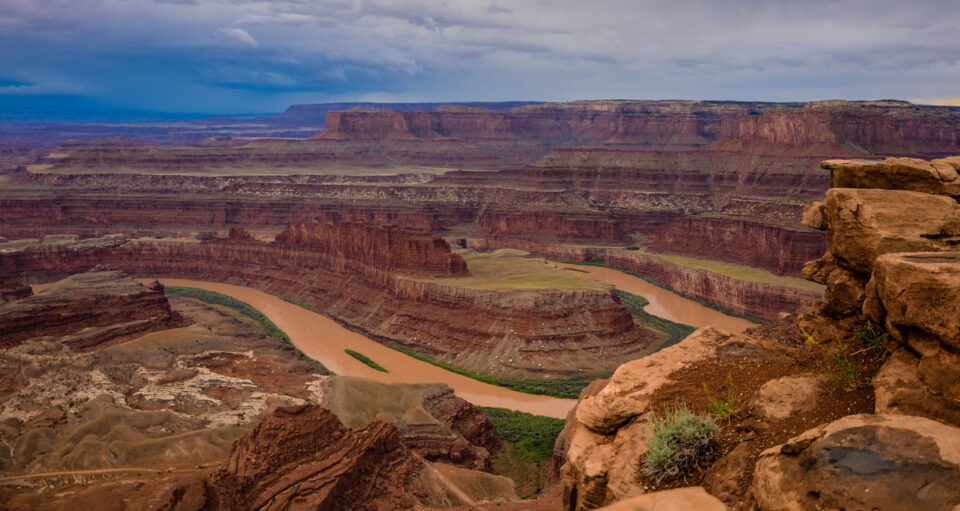
The diffused light provided by an overcast sky can soften shadows and reduce harsh contrasts, creating a calming and often dramatic atmosphere in your photograph.
In these conditions, colors often appear more vibrant, and details can be more easily observed. It’s an ideal time to capture landscapes since the cloud cover acts like a natural diffuser.
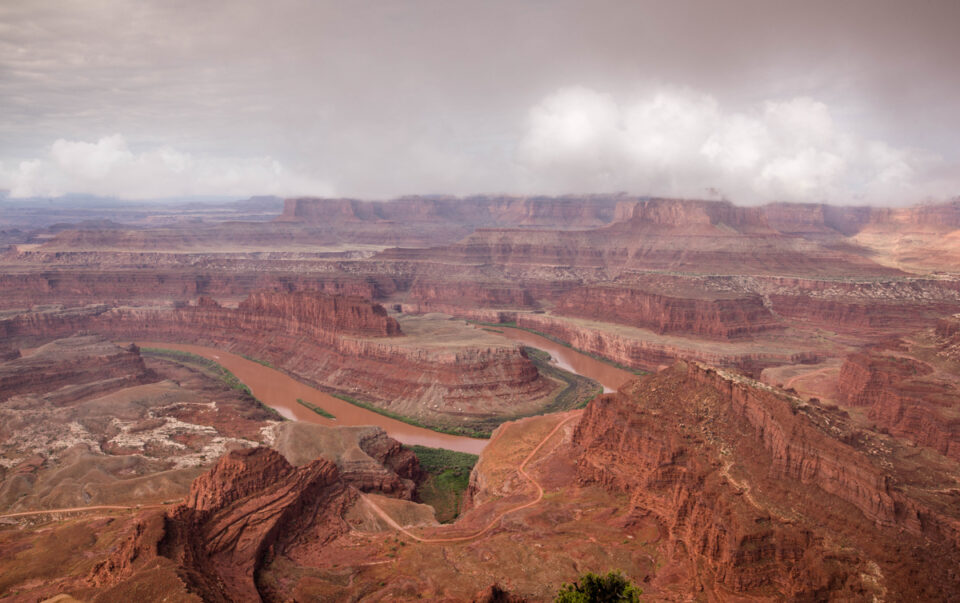
When it’s a dreary day, use this to your advantage by composing your shots to maximize the visual impact of the clouds and their formations.
